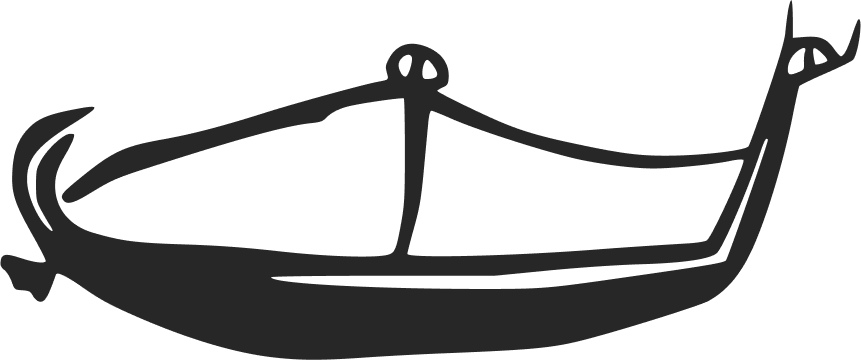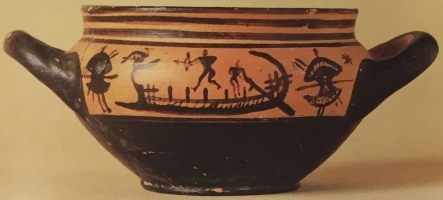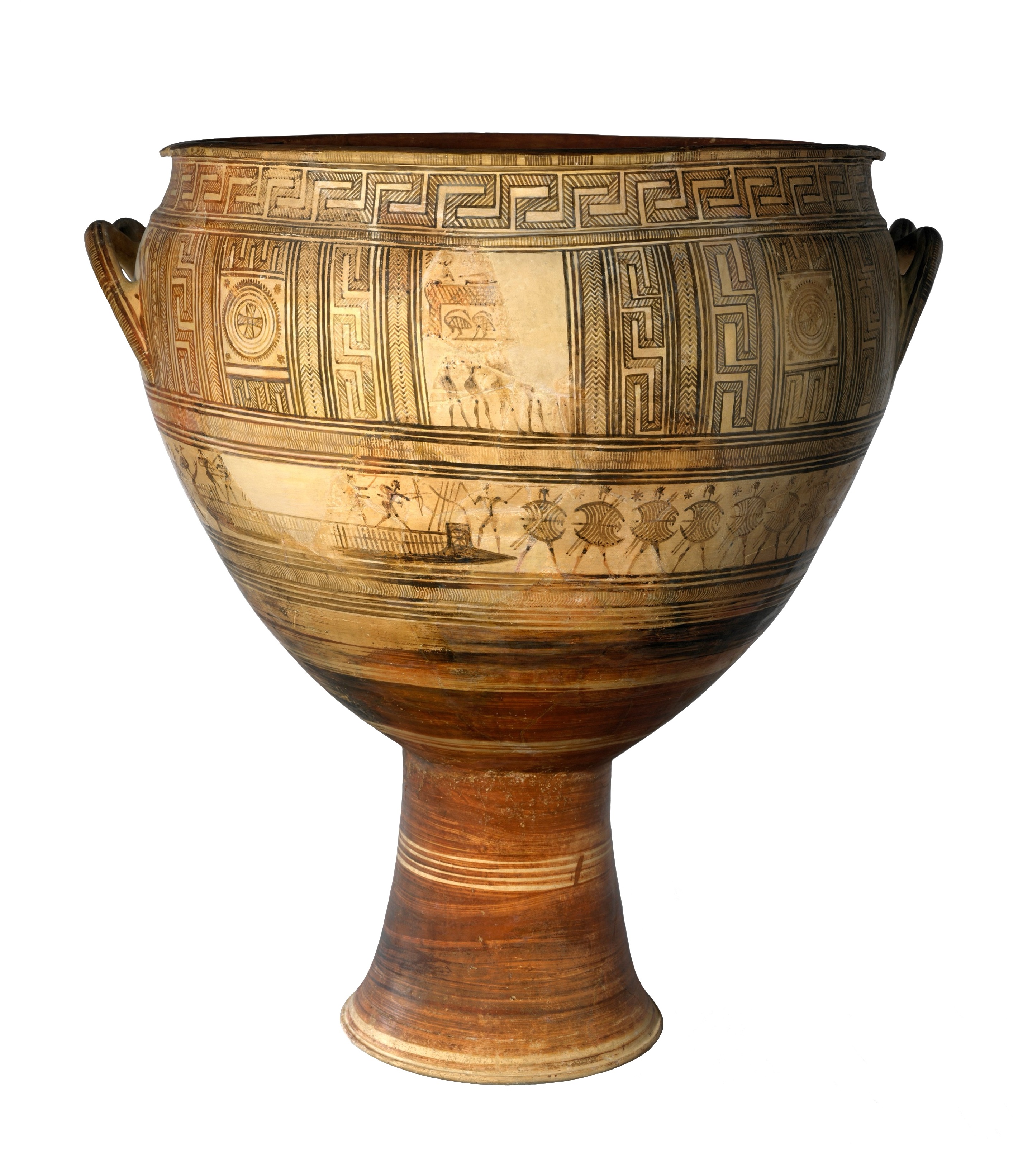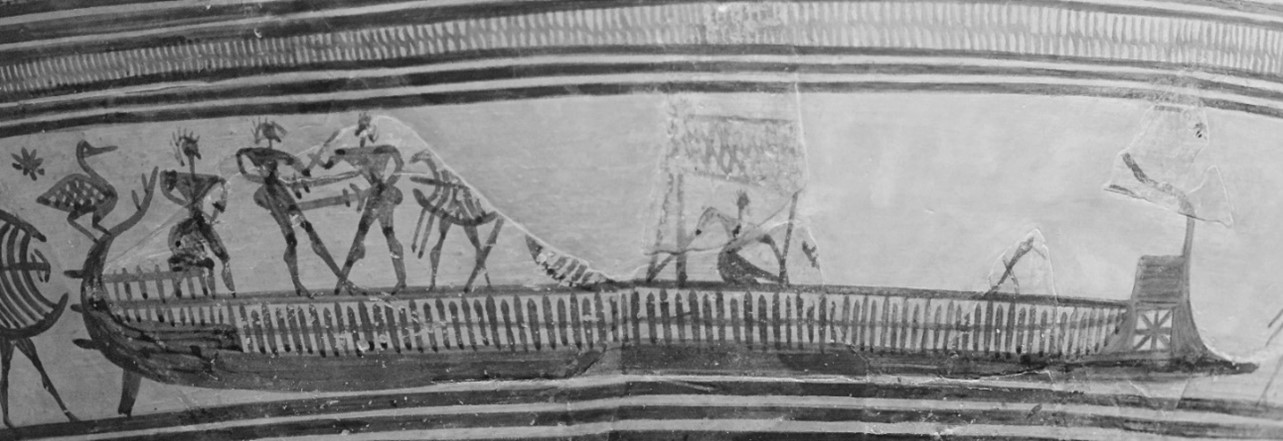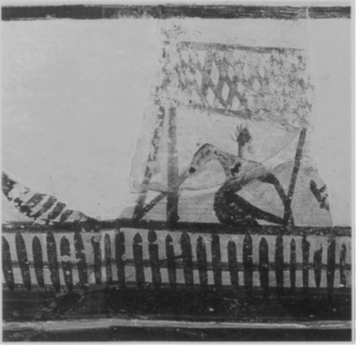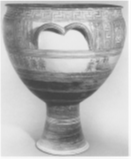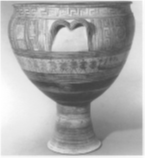Two ships to the right, identical in every way except for the presence of a mast and sail on the second one. Flat, very low hull, with a massive square bow with a concave post integrating the bow projection and ending in a slightly S-shaped horn. Eye drawn as an eight-pointed star within a reserved rectangle decorates the bow screen. Curved high sternpost ending in a slender tip decorated with two short projections. Stern has an aftercastle and an open balustrade, with the blade of a thin rectangular steering oar emerging almost vertically beneath. There are two horizontal lines running parallel to the hull which extend into short plank protrusions from the sternpost. These are connected by 61 vertical lines on ship A, and 84 on ship B. While the painter was therefore not highly concerned with their precise number, great care was expended to depict them in a specific pattern, where these alternate between a vertical line that touches the upper horizontal line, followed by another that only reaches mid-way past the lower horizontal. The lower horizontal therefore represents the railing with tholepins depicted as the shorter vertical strokes, while the upper horizontal is a slightly raised deck supported by stanchions. Ship B has a mast amidships with a rectangular crosshatched unfurled sail, suspended from a yard and anchored to the deck by the sail-yard braces. Only half a section of the sail survives forward of amidships, but the fact that it extended beyond the mast to the left is confirmed by bits of glaze that show more crosshatching, as well as the lower edge of a sail-yard brace crosses the leg of the striding warrior with a shield.
Two single-levelled galleys
A122
c. 800-775 B.C. (Middle Geometric II, late first quarter of the 8th century)
Attica
H: 99.1 cm; diameter: 94 cm
Attic pedestalled krater, high slightly offset rim, ovoid body, flaring base and two bull's head handles. Hole in the bottom for libations. Workshop of the painter of New York
Basch 1987: 178-79, no. 374; Kirk 1949: 99, no. 6; Mertens 2010: 46-52, no. 5; Moore 2000: 13-38, figs. 1-14; Morrison and Williams 1968: 31-32, geom. 25, pl. 5, 6a-b; Wedde 1996: 581; 1999a: 510, fig. 5; 2006: 262, fig. 14
The high pedestalled krater in monumental form appears during the MG and lasts through LG I when it reaches the height of its popularity (beginning of the 8th to the third quarter of the 8th century). This exemplar clearly served as a grave marker and combines both figural and non-representational decoration. The figural elements are confined to three areas: the central metope on each side of the body in the handle zone comprised of a *prosthesis* scene, the handle panels and spandrels where additional mourners are shown, and an uninterrupted frieze around the entire vase below the handle zone, consisting of two warships alternating with processions of warriors. The ships themselves are near identical, with differences in terms of the lively combat scenes taking place on each one. A bird with a crosshatched body is perched on the sternpost. It is clear that the ship on side A is beached, while the ship on Side B is probably getting ready to sail off. The files of warriors between the ships are drawn on a larger scale to fit the frieze size. From side A to B there are thirteen preserved, while on the other only eight remain, with the lower legs of three more and room for another, twelve in total. The warriors face right, each wearing a crested helmet and carrying a Dipylon shield and two spears. There is an eight-pointed star in front of the head of each warrior. These schematic, stiff and uniform files of warriors are to be taken as completely separate from the self-contained ship battle scenes.
Side A: Ship facing right, with four distinct parts of a battle taking place from stern to bow: 1) in the stern area, two warriors equipped with swords locked in close combat, simultaneously stabbing each other in the torso, with their free hand outstretched, reaching towards each other's helmets. The right warrior appears to have taken a hold of the crest of his opponent's helmet, tugging at it. 2) the calf of the leg of a warrior facing right, with the ends of two spears visible, similar to the procession of warriors with Dipylon shields; 3) a spearman fighting a now lost opponent. He is located immediately behind the archer with his back to him (facing left), about to hurl a spear at the missing enemy; 4) a confrontation at the bow between a spearman and an archer. The attacker standing on the ship's bow projection has his left hand extended backwards ready to throw a spear while trying to take another from a stash of four spears stacked at the bow. Facing him is an archer ready to shoot.
Side B: Ship facing right. A helmeted warrior facing right and sitting at the stern observes a duel happening in front of him. The dueling warriors are near identical to those at the stern of side A, fighting in close combat with swords, with similar hand gestures of their weapon free hand. Behind them is a warrior armed with a Dipylon shield and two spears striding right. The center of the ship is occupied by the mast with an unfurled crosshatched sail suspended from a yard and anchored to the deck by the sail-yard braces. Below the preserved half of the sail, a person sits on deck with outstretched arms. Lines extending from each hand to the base of the mast and the sail-yard brace respectively suggests the person is fettered. The depiction of hair instead of a helmet suggests the captive is female. There are two Dipylon shields lying on the deck, one in front and one behind her. Near the prow, the lower legs of two warriors remain, facing left. One of them originally carried a spear at waist level rather than poised for throwing.
These scenes provide some of the clearest evidence for a deck, which is indicated both by the warriors standing on the upper horizontal line, and by the pattern of every second vertical line which rises above the railing and the tholepins to support it. Wedde argues that the height of this deck does not appear sufficient for the rowers to take cover below it, which poses problems regarding whether it should be interpreted as running down the center or along the gunwales (Wedde 1996: 581; 1999: 510). The sitting helmsman on ship B appears to be dangling his feet into an uncovered section. The bow morphology with the developed bow projection resembles the later LG I Dipylon vessels. The fact that the two ships appear unusually long probably has to do with the artist's need to accommodate all the figures on deck. Another accommodation is observable for the sail, which is drawn a lot shorter so as to end above the head of the captive figure sitting below it.
Basch, L. 1987. Le musée imaginaire de la marine antique. Athens: Institut Hellénique pour la preservation de la tradition nautique.
Kirk, G.S. 1949. “Ships on Geometric Vases.” BSA 44: 93-153, pls. 38-40.
Mertens, J. R. 2010. How to Read Greek Vases. New York: The Metropolitan Museum of Art.
Moore, M. B. 2000. “Ships on a “Wine-Dark-Sea” in the Age of Homer,” Metropolitan Museum Journal 35: 13-38.
Morrison, J.S. and R.T. Williams. 1968. Greek Oared Ships: 900-322 B.C. Cambridge: Cambridge University Press.
Wedde, M. 1996. “From Classification to Narrative: The contribution of Iconography towards writing a History of Early Aegean Shipbuilding,” MHR 11.2: 117-164.
―――. 1999a. “Decked Vessels in Early Greek Ship Architecture,” in H.E. Tzalas (ed.) Tropis V: 5th International Symposium on Ship Construction in Antiquity. Nauplia, 26, 27, 28 August 1993. (Hellenic Institute for the Preservation of Nautical Tradition). Athens: Hellenic Institute for the Preservation of Nautical Tradition, pp. 505-526.
―――. 2006. “Pictorial Evidence for Partial System Survival in the Greek Bronze Age to Iron Age Transition,” in E. Rystedt and B. Wells (eds.) Pictorial Pursuits: Eigurative Painting on Mycenaean and Geometric Pottery. Paper from Two International Round-Table Conferences on Mycenaean and Geometric Pottery at the Swedish Institute at Athens in 1999 and 2001, Stockholm: Svenska Instituted I Athen, pp. 255-269.
